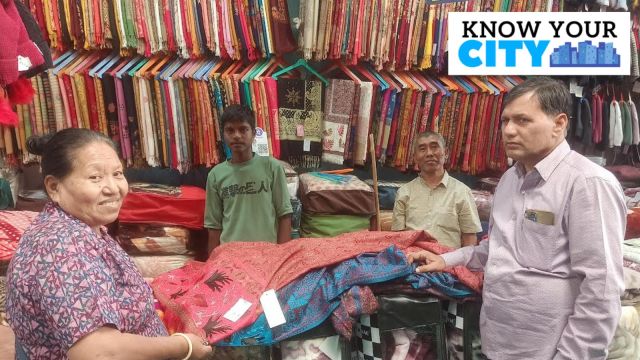Know Your City: A slice of Tibet in Ahmedabad
The market on the Sabarmati riverfront offers a range of products from Kashmiri stoles to hand-knitted woollens at affordable prices.
 Dawa Gyaltso (left), 60, and her husband, Dawa Gyaltso (second from right), run a shop in the Tibetan Refugee Sweater Bazaar in Ahmedabad. (Express Photo by Parimal Dabhi)
Dawa Gyaltso (left), 60, and her husband, Dawa Gyaltso (second from right), run a shop in the Tibetan Refugee Sweater Bazaar in Ahmedabad. (Express Photo by Parimal Dabhi)When you see the ground covered with colourful tents, prayer flags crisscrossing above them, Thangka paintings and posters of the Dalai Lama on the walls, you know the Tibetans have arrived in Ahmedabad.
At least 110 Tibetan refugee families from Himachal Pradesh and Karnataka camp here till January, catering to the winter needs of the city. Vibrant as a fair, the market this time is on the Sabarmati riverfront, with its inventory ranging from Kashmiri stoles to hand-knitted woollens warm enough for a winter vacation in the hills, all at affordable rates.
Although it has been 35 years since it formally started commercial operations in Ahmedabad, under the banner of the Tibetan Refugee Sweater Sellers Association (TRSSA), the story of the market dates back to 1969-70 when the Tibetans started coming to Gujarat during winter to sell woollens.
The president of TRSSA, Tenzin Gyaltsen, 49, says, “I was just a year old when I came to Ahmedabad with my father. I have heard from him that we started coming to Gujarat from 1969-70. Initially, our forefathers sold woollens scattered on roadsides. They were facing a lot of hardships from police and municipal bodies in the absence of proper information.”
 The president of TRSSA, Tenzin Gyaltsen, 49, at the bazaar on the Sabarmati riverfront. (Express Photo by Parimal Dabhi)
The president of TRSSA, Tenzin Gyaltsen, 49, at the bazaar on the Sabarmati riverfront. (Express Photo by Parimal Dabhi)
Gyaltsen says that it was in 1989 that they formed a group called TRSSA under the guidance and help of an Ahmedabad-based Buddhist, the late P G Jyotikar.
“Jyotikar sir saw some of us selling woollens on the side of Relief Road while police were removing them from the roadside. Introducing himself as a fellow Buddhist, he (Jyotikar) asked some of them to come to his home. He then guided them to form an association and seek an open place on rent from the Ahmedabad Municipal Corporation. The association was formed, and the first Tibetan market came upon an open plot of land near Sardar Bridge, next to Ful Bazaar (the flower market) in 1989,” recalls Tenzin.
According to Gyaltsen, this was the first such Tibetan sweater market set up under a formal group of Tibetans in India, which was replicated in many other states later.
Jyotikar was a leading Ambedkarite scholar from Ahmedabad and one of the first generation of Dalits to convert to Buddhism in Gujarat. Thus, Jyotikar’s portrait adorns the wall of the Tibetan market office, and his son Amit is a trustee in the TRSSA.
“For us, he is like an angel sent by God. We are grateful to him forever,” says Gyaltsen.
Since 1989, TRSSA has been setting up bazaars in various parts of the city, such as Maninagar, Paldi, Navrangpura, Naranpura, Memnagar, Kankaria, and so on.
According to Gyaltsen, only around 110 Tibetan families which joined hands and formed the association in 1989 can have a shop in the market. Due to the paucity of space in setting up the market in the city, the association is not open to new members. Each year, shops are allocated through a lucky draw, and the goods are sold at fixed prices.
 Tenzin Gyaltsen at the office of Tibetan Market. (Express Photo by Parimal Dabhi)
Tenzin Gyaltsen at the office of Tibetan Market. (Express Photo by Parimal Dabhi)
They have set up their market on the the western side of the Sabarmati Riverfront near Vallabh Sadan and near the Blind People’s Association in Vastrapur. On the Riverfront, the Tibetan market has 158 shops, and in Vastrapur, it has 58 stalls.
“In the initial years, we used to sell handmade woollens. But, over the years, the demand has increased a lot. And so we have started sourcing the woollens and winterwear from different locations, Ludhiana and Delhi being the major ones. We give orders to manufacturers based on our designs. And they make it as per order. We have been coming to Ahmedabad for years and we know the taste of the people here. Nobody can beat our rates or the variety of designs,” says Gyaltsen.
Krishna Panchal, who lives on SG Highway, is a regular at the Tibetan market wherever it camps in the city. “The prices and quality of woollens are very good here compared to the malls,” she says.
The management committee, which is elected every year, comes months before the market is due and does all the formalities like taking permissions and erecting the shamiana. The families rent homes in West Ahmedabad areas like Usmanpura, Navrangpura and Paldi, which are closer to the market just before they open.
But life in Ahmedabad has not been easy, given its high temperatures (average winter temperature is 25-27 degrees Celsius). Tsering Dolma, 60, a regular vendor, says, “In the initial days after we come to Ahmedabad, we fall ill due to different climatic conditions here. Also, due to warmer conditions in recent years and shorter winters, our sales have also been hit.”
“But one aspect about Ahmedabad that I like the most is that it is very safe, even for women. We can move around alone anytime in the city. No other city in the country is as safe as Ahmedabad,” says Dolma, who runs the shop with husband Dawa Gyaltso.
 Tenzin Gyaltsen and Amit Jyotikar at the office of Tibetan Market on Sabarmati riverfront in Ahmedabad. (Express Photo by Parimal Dabhi)
Tenzin Gyaltsen and Amit Jyotikar at the office of Tibetan Market on Sabarmati riverfront in Ahmedabad. (Express Photo by Parimal Dabhi)
Amit says, “Till now, TRSSA was an unregistered group. But this year, we have formally registered it under the Societies Registration Act so that we can make some formal official demands related to Tibetans in Gujarat and other official requirements like opening a bank account, etc..”
Amit, also the president of the Gujarat Chapter of the India-Tibet Friendship Society, says their immediate demand is not to charge GST on the rent for the land and not raise the rent by 10 per cent every year.
“We had also demanded before the government to grant the Tibetans land at concessional rates to set up their colony in Gujarat like in other states of India. And to grant land at a token rate so the market can be permanent,” he says.
Amit said the Tibetans had donated Rs three lakh to the Chief Minister’s Relief Fund during Covid-19. While the Tibetans also have markets in other cities, Ahmedabad is the biggest in Gujarat.







